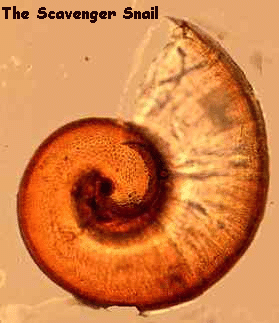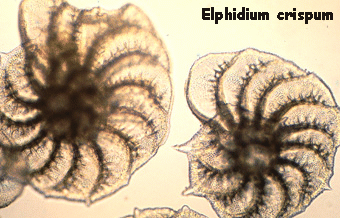
The Snail and the Foram Image by Jan Parmentier(NL)
Text By Brian Darnton (GB)

In the living species along our shores today they are nontheless useful in monitoring the general temperature, pollution level and the salinity of the sea water. In cases of pollution the species may be depressed or reduced in number and they may well be joined by scavengers that enjoy an enriched solution with a raised organic content.
|
|
The illustrations show a rock pool at flood and ebb tides near a sewage outfall that will shortly be relieved by a new and very expensive treatment plant. During the last few years the species present have been reduced to one, in the form of the dominant Elphidium crispum and a microscopic scavenger snail (shown at article head) has joined them on the fronds of the local seaweeds during the spring and summer. It is slightly larger than the Elphidium illustrated below.
It will be very interesting to see what happens to the pool when the new sewage plant is introduced next year.

Published in January 1999 Micscape Magazine.
Please report any Web problems
or offer general comments to the Micscape Editor,
via the contact on current Micscape Index.
Micscape is the on-line monthly
magazine of the Microscopy UK web
site at Microscopy-UK